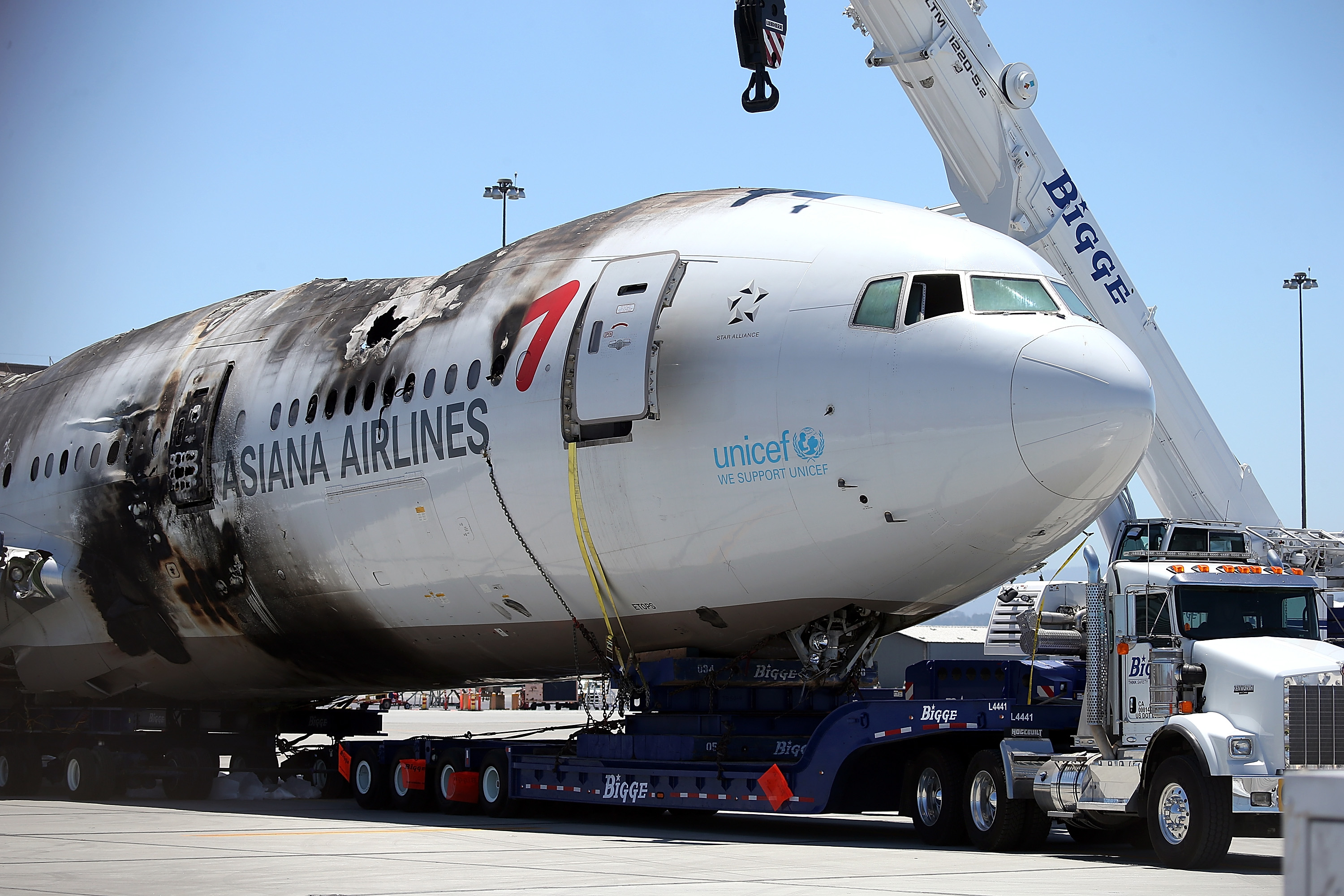Asiana Airlines acknowledged for the first time that the "probable cause" of the fatal crash in San Francisco last July was its pilot flying too slow, according to documents federal investigators released today.
However, the airline also said "inconsistencies" in the Boeing 777-200ER's autothrottle contributed to the crash. The airline's positions submitted earlier this month were part of hundreds of pages of documents the National Transportation Safety Board will consider while investigating the crash that killed three passengers and injured more than 200.
Asiana said the plane's navigation equipment "led the crew to believe that the autothrottle was maintaining the airspeed set by the crew" and instead the equipment "disabled the aircraft's minimum airspeed protection." The airline also said test pilots had trouble landing under the same conditions in simulators.
The Asiana documents are just one portion of what the NTSB will consider as it determines the probable cause of the crash and any recommendations resulting from it. Investigators hope to finish the case before the anniversary of the crash July 6.
Asiana Flight 214 slammed into a seawall at the end of the runway in San Francisco before spinning around, breaking into pieces and burning. Three passengers died in the incident, one of whom was run over by a fire truck, and more than 200 were sent to hospitals.
NTSB investigators earlier revealed that the plane was traveling lower and slower than intended when it struck the seawall. The plane was traveling about 119 mph, despite a goal of 158 mph.
But NTSB Chairman Deborah Hersman has said generally that even if there was confusion about how equipment worked, pilots are obligated to monitor their equipment and pay attention to their surroundings, to prevent crashes. She drew no conclusions yet about the Asiana incident.
At a December hearing of the NTSB, investigators said the flying pilot, Lee Kang Kuk, was landing for the first time at San Francisco. He had spent just 43 hours flying the 777, although he had clocked 9,684 hours on a variety of other jets. Another pilot serving as an instructor on the flight, Lee Jung Min, had spent 3,208 hours flying 777s out of 12,307 total flying hours.
"It's not a lack of pilot training," said Thomas Haueter, a former director of NTSB's Office of Aviation Safety, who is consulting for Asiana. "These guys were extraordinarily well-trained. They get very specific training about flying into San Francisco."
In the latest documents, Asiana said the plane's autopilot changed "for an unknown reason" as the plane was about 1,600 feet off the ground approaching the runway. The autopilot changed from so-called "pitch" mode to "flight-level change" mode, which commanded the plane to climb back to 3,000 feet as if it had missed its targeted approach, and raised its speed and height.
In interviews after the accident, none of the three pilots in the cockpit recalled the flying pilot "or anyone else pressing the (flight-level change) button," according to Asiana.
Within three seconds, flying pilot Lee Kang Kuk disconnected the autopilot, called out "manual flight" and moved throttles to idle, according to Asiana. But doing that put the engines in "hold" mode that kept them idling, which effectively disconnected the autothrottle so that it wouldn't maintain a minimum speed, the airline said.
A noise alarm sounds if the autothrottle is disconnected, but not when it is in "hold" mode, the airline said.
"The flight crew believed that the autothrottle system would maintain the commanded airspeed through the final approach," the airline said.
The FAA had "strongly" encouraged Boeing to enhance its software so that the autothrottle would "wake up" during large changes in air speed, after an FAA test pilot raised the same concern while flying the manufacturer's 787 for certification in 2010.
But Boeing hasn't done so. At the December hearing, Robert Myers, Boeing's chief engineer of flight-deck engineering, said if pilots are surprised by the automation, they are expected to use basic skills and manually fly the plane.
"If the airplane is not doing what they expect it to do, that they can disconnect the automation altogether and fly manually," Myers said.
NTSB conducted simulator tests in January with crews of 777 pilots from Boeing and the FAA that found they had trouble with an approach similar to Asiana's, according to the airline.
Each crew flew 10 landings — five standard and five representing the higher and faster path that Asiana was following. In the 10 flights mirroring the Asiana approach, crews descended more steeply than the airline's recommended rate of 1,000 feet per minute every time, according to the airline.
In four of those cases they set off the plane's warning for descending too fast. In two other tries they were considered "unstable" for flying too high or too fast, which means the pilot should consider aborting the landing and flying around the airport for another try, according to the airline.
To prevent future crashes, Asiana urged the NTSB to recommend that FAA require Boeing to put better warnings in its training manuals and aboard its aircraft about the autothrottle.
Asiana also suggested a noise alert for low airspeed, like what 737 aircraft have, early enough to allow a pilot to abort a landing and try again. The planes' current low-airspeed alert sounded 11 seconds before the San Francisco crash, which was too late for pilots to circle around.
Asiana said it revised its training thoroughly after the accident, to prevent another occurrence. The airline canceled 80 flights after the crash so that pilots could receive extra training that was already more than the Korean government required.


